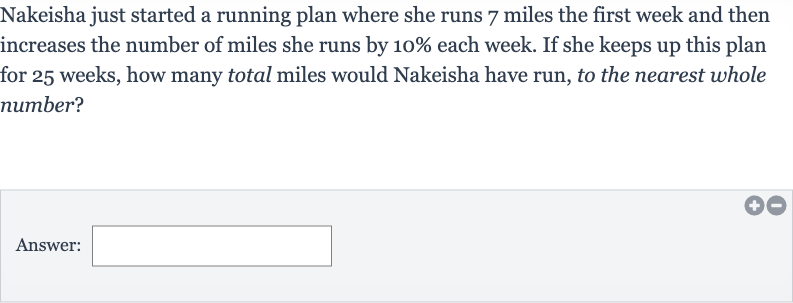AI tutor
Welcome to Bytelearn!
Let’s check out your problem:

Nakeisha just started a running plan where she runs miles the first week and then increases the number of miles she runs by each week. If she keeps up this plan for weeks, how many total miles would Nakeisha have run, to the nearest whole number?Answer:
Full solution
Q. Nakeisha just started a running plan where she runs miles the first week and then increases the number of miles she runs by each week. If she keeps up this plan for weeks, how many total miles would Nakeisha have run, to the nearest whole number?Answer:
- Identify initial amount and rate: Identify the initial amount of miles and the rate of increase.Nakeisha starts with miles in the first week and increases her running distance by each week.Initial miles Rate of increase or
- Calculate total miles per week: Calculate the total miles run for each week.The total miles run in each subsequent week can be calculated using the formula for the th term of a geometric sequence:Week miles = We will use this formula to calculate the miles run each week and then sum them up for weeks.
- Calculate total miles over weeks: Calculate the total miles run over weeks.We need to sum up the miles for each week from week to week .Total miles = This is the sum of a finite geometric series.
- Use formula for sum of series: Use the formula for the sum of a finite geometric series.The sum of the first terms of a geometric series is given by:We will substitute , , and into this formula to find the total miles.
- Perform calculation using formula: Perform the calculation using the formula.
- Calculate exact total and round: Calculate the exact total and then round to the nearest whole number.First, calculate , then substitute it back into the formula to find .After finding , round it to the nearest whole number.
- Use calculator to find total: Use a calculator to find and then find .Rounded to the nearest whole number, miles.
More problems from Exponential growth and decay: word problems
QuestionGet tutor help
QuestionGet tutor help
QuestionGet tutor help
QuestionGet tutor help
QuestionGet tutor help
QuestionGet tutor help
QuestionGet tutor help
QuestionGet tutor help
QuestionGet tutor help
